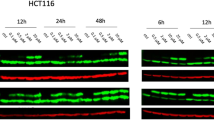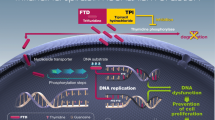Abstract
5′-Deoxy-5-fluorouridine (dFUR) is used orally to treat human malignancies. This study compared the antitumor activity and toxicity of rectally and orally administered dFUR. A 7-day treatment of dFUR (350 or 700 mg/kg/day) was infused rectally over 30 min or administered by oral gavage (500 mg/kg/day) to rats bearing transplanted dimethylhydrazine-induced colon tumors. The oral treatment was previously shown to produce a 82% cure of the tumor-bearing animals. The tumor weight after 7 day treatment was compared to that before treatment. The size of the tumor in the saline-treated control group (N = 6) increased by 55%. The maximum tumor size reductions by drug treatments were 40% for the 350-mg/kg rectal dose (N = 5), >99% for the 700-mg/kg rectal dose (N = 10), and 100% for the 500-mg/kg oral dose (N = 4). The 350-mg/kg rectal dose did not produce any cures, while the 700-mg/kg rectal dose produced 80% cures and the 500-mg/kg oral dose 100% cures. The cured animals remained tumor-free during the observation period of 163 to 243 days. The tumor-bearing rats were euthanized between 46 and 132 days when they appeared moribund or when the tumor began to ulcerate. The 700-mg/kg rectal and 500-mg/kg oral treatments produced greater weight loss than saline, suggesting a drug-induced intestinal toxicity. After rectal drug treatment, the animal weight returned to pretreatment level within 3 days, indicating a rapidly reversible intestinal toxicity. The oral group suffered a greater weight loss than the rectal group and took more than 10 days to recover. This suggests that the intestinal toxicity of the rectal treatment was less severe than the oral treatment. The leukocyte and thrombocyte counts after drug treatments were not significantly different from the pretreatment levels, which suggests an absence of myelosuppression. In summary, these results indicate that dFUR by rectal administration had antitumor activity with minimal host toxicity.
Similar content being viewed by others
REFERENCES
B. A. Chabner. In B. A. Chabner (ed.), Pharmacologic Principles of Cancer Treatment, W. B. Saunders, Philadelphia, 1982, pp. 183–212.
R. Abele, P. Alberto, R. J. Seematter, F. Germano, R. Heintz, and W. Bollag. Cancer Treat. Rep. 66:1307–1313 (1982).
P. Alberto, M. Rozencweig, M. Clavel, P. Siegenthaler, F. Cavali, S. Gundersen, U. Bruntsch, J. Renard, and H. Piendo. Cancer Chemother. Pharmacol. 16:78–79 (1986).
T. Taguchi, K. Kimura, and T. Saito. Proceedings of 3rd European Conference of Clinical Oncology and Cancer Nursing, 1985, p. 12.
J. L.-S. Au, J. S. Walker, and Y. M. Rustum. J. Pharmacol. Exp. Ther. 227:174–180 (1983).
J. L.-S. Au, H. K. Slocum, and Y. M. Rustum. Cancer Drug Deliv. 4:137–144 (1987).
F. Trave, L. Cannobio, J. L.-S. Au, and Y. M. Rustum. J. Natl. Cancer Inst. 78:527–532 (1987).
A. G. deBoer, F. Molenaar, L. G. J. deLeede, and D. D. Breimer. Clin. Pharmacokin. 7:285–311 (1982).
L. G. J. deLeede, A. G. deBoer, G. P. L. M. Roozen, and D. D. Breimer. J. Pharmacol. Exp. Ther. 225:181–185 (1983).
T. A. Loomis. Essentials of Toxicology, Lea & Febiger, Philadelphia, 1978.
R. H. Riddell. Pathology of Drug-Induced and Toxic Diseases, Churchill Livingstone, New York, 1982.
L. Ott. An Introduction to Statistical Methods and Data Analysis, Duxbury Press, Boston, 1984.
A. J. Creskoff, T. Fitz-hugh, and E. J. Farris. In J. Q. Griffith and E. J. Farris (eds.), The Rat in Laboratory Investigation, J. B. Lippincott, Philadelphia, 1971, p. 406.
D. H. Ringler and L. Dabich. In H. J. Baker, J. R. Lindsey, and S. H. Weisbroth (eds.), The Laboratory Rat. Vol. I. Biology and Diseases, Academic Press, New York, 1979, p. 105.
J. L.-S. Au and L. C. Gunnarsson. Pharm. Res. 6:323–327 (1989).
F. P. Brooks. In F. P. Books (ed.), Gastrointestinal Pathophysiology, Oxford Press, London, 1974, p. 28.
I. Taylor, D. Machin, M. Mullee, G. Trotter, T. Cooke, and C. West. Br. J. Surg. 72:359–365 (1985).
N. Wolmack, B. Fisher, and H. Z. Rockette. In S. E. Salmon (ed.), Adjuvant Therapy of Cancer V, Grune & Stratton, Orlando, Fla., 1987, pp. 531–543.
Author information
Authors and Affiliations
Rights and permissions
About this article
Cite this article
Bramer, S.L., Gunnarsson, L.C. & Au, J.LS. Biologic Activity of 5′-Deoxy-5-fluorouridine by Rectal Administration. Pharm Res 6, 318–322 (1989). https://doi.org/10.1023/A:1015950508618
Issue Date:
DOI: https://doi.org/10.1023/A:1015950508618




